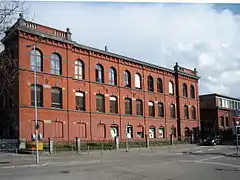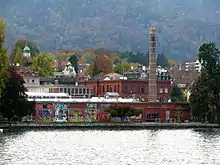Rote Fabrik
Rote Fabrik (Red Factory) is a former factory in the Wollishofen neighbourhood of Zürich, Switzerland. It is now used as a music venue and cultural centre. It is so named because the buildings are made of red brick, but also because left-wing parties were part of the campaign to turn the location into a cultural centre.
| Rote Fabrik | |
|---|---|
 Rote Fabrik, viewed from Seestrasse | |

| |
| General information | |
| Location | Zürich, Switzerland |
| Address | Seestrasse 395 |
| Completed | 1892 |
| Technical details | |
| Floor count | 3 |
| Design and construction | |
| Architect | Carl Arnold Séquin-Bronner |
| Architecture firm | Sequin and Knobel |
| Website | |
| rotefabrik | |

History
The factory
The Rote Fabrik was built in 1892 for the Seidenfirma Henneberg company, according to a design by the architect Carl Arnold Séquin-Bronner. In 1899, the Henneberg company was taken over by the Stünzi Söhne Seidenwebereien company, based in Horgen. In 1940, the factory was taken over by the ITT Corporation. In 1972, the city acquired the factory and planned to demolish the building in order to widen the adjacent Seestrasse.
The cultural centre
In 1974 the Social Democratic Party of Switzerland (SP) launched a proposal to transform the factory building into a cultural centre. As a result, studios were set up for artists and cultural events were held. In 1977, voters made the choice for the preservation of the building and use as a cultural centre.
A three-day celebration of the Zürich Opernhaus and the opening of a festival was celebrated on 30 May 1980. About 200 uninvited protesters demanded an autonomous youth centre. The Stadtpolizei Zürich and state Kantonspolizei Zürich police corps were informed beforehand, and stationed in the foyer of the opera house. As the young people occupied the stairs, the demonstration transformed into a street battle between the demonstrators and the police, who were equipped with water cannons, tear gas, and rubber bullets. The city of Zurich had originally planned to grant CHF 61 million to the opera house for a renovation and an extension of the building, but nothing to the planned Rote Fabrik in Zürich-Wollishofen, on the other side of the Zürichsee lakeshore.[1] These subsidies, plus a lack of alternative governmental cultural programs for youth in Zürich, resulted in the so-called Opernhauskrawalle at the present-day Sechseläutenplatz square in Zürich. A first political compromise was the so-called AJZ, a temporary youth centre at the Zürich main station. The most prominent politician involved was Emilie Lieberherr, then member of the city's executive (Stadtrat) authority.[1][2]
On 25 October 1980, the cultural centre Rote Fabrik opened. Music and theater were the focus of activities. Some independent theater groups which gained increasing influence in the local cultural scene made their debuts at the Rote Fabrik. A referendum in 1987 decided that the Rote Fabrik should be used as an alternative cultural centre and also subsidised.
In the early 1990s, the area was redeveloped. In 2002, the subsidies were adjusted to 2.3 million francs. With this money it became possible to organise more than 300 events annually.
Since 2008, Dock18, a space for new media culture, has been located at the location. A restaurant, Ziegel oh Lac, is located in the rear of the building.
2010 was the 30th anniversary celebration for the Rote Fabrik. It will continue to run as a collective.
Accessibility
Rote Fabrik can be reached by the 161, 165 and N15 buses,[3][4] while trams 5, 6, 7, 8 and 13 service Post Wollishofen, a few hundred yards to the northwest.[5]
References
- Franz Kasperski (2015-01-16). "Der heisse Sommer 1980: "Züri brännt"" (in German). SRF Kultur. Retrieved 2015-01-17.
- "Diskussion zu den Zürcher Jugendunruhen ("CH-Magazin" vom 15.7.1980)" (in German). SRF Kultur. 1980-07-15. Archived from the original on 2014-05-19. Retrieved 2015-01-17.
- Rote Fabrik northbound bus stop - Google Maps
- Rote Fabrik southbound bus stop - Google Maps
- Post Wollishofen - Google Maps